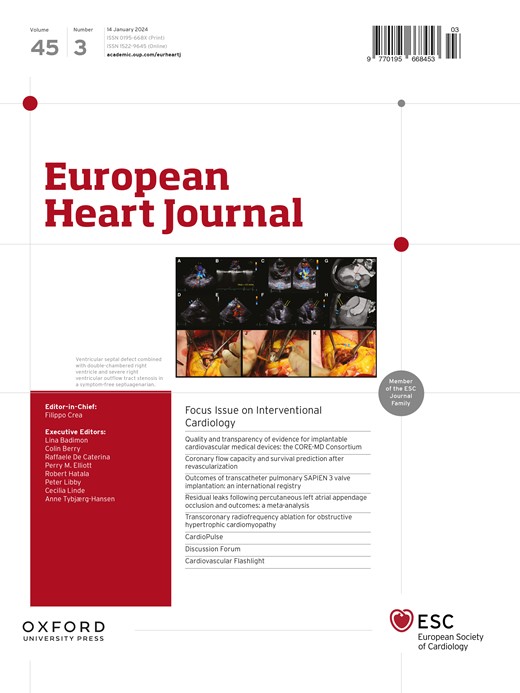Transcriptomic biomarkers related to cardiac disease in childhood cancer survivors: a case-control study.
IF 35.6
1区 医学
Q1 CARDIAC & CARDIOVASCULAR SYSTEMS
引用次数: 0
Abstract
BACKGROUND AND AIMS Cardiotoxic treatments like anthracyclines and heart-directed radiotherapy increase the risk of cardiac diseases (CDs) in childhood cancer survivors (CCSs), but individual differences in CD incidence are not fully understood. This study aims to identify transcriptomic biomarkers associated with CD occurrence after childhood cancer treatment. METHODS A matched case-control study was conducted on a sample of 330 CCS: 165 cases with CD and 165 CD-free controls. The expression of 8557 genes was investigated to select those associated with CD and heart failure (HF), using three stabilization approaches derived for the conditional logistic regression with Lasso (Percentile lasso, Bolasso, and Sublasso). The intersection of the three selected gene sets formed the final selection. The interactions between cancer treatment doses and selected genes were investigated. RESULTS One promising gene, NFE2L2, constituted the final selection, and its expression was lower in cases than in controls [CD: odds ratio (OR) .16, 95% confidence interval (CI) .09-.29; HF: OR .11, 95% CI .03-.37]. No interaction between treatment doses and NFE2L2 expression levels was found in our study. Incorporating NFE2L2 gene expression into prognostic models improved discrimination between cases and controls compared with models based solely on clinical and treatment variables [CD: area under the curve (AUC) .85 vs .66; HF: AUC .87 vs .77]. CONCLUSIONS Using high-dimensional data selection methods has enabled the identification of the gene NFE2L2, associated with CD and HF in CCS. Further research is needed to validate this finding and achieve a better understanding of the biological mechanisms leading to cardiac toxicities and so to develop risk-adapted treatment and surveillance strategies.儿童癌症幸存者中与心脏病相关的转录组生物标志物:一项病例对照研究
蒽环类药物和心脏定向放疗等心脏毒性治疗增加了儿童癌症幸存者(CCSs)患心脏病(CD)的风险,但CD发病率的个体差异尚不完全清楚。本研究旨在确定与儿童癌症治疗后CD发生相关的转录组生物标志物。方法对330例CCS患者进行配对病例-对照研究,其中165例有CD, 165例无CD。通过使用Lasso(百分位Lasso、Bolasso和subblasso)条件逻辑回归衍生的三种稳定方法,研究8557个基因的表达,以选择与CD和心力衰竭(HF)相关的基因。三个被选择的基因集的交集形成了最终的选择。研究了癌症治疗剂量与选定基因之间的相互作用。结果最终选择了一个有希望的基因NFE2L2,其表达量低于对照组[CD:比值比(OR)]。16, 95%置信区间(CI) .09-.29;Hf:或者。[11, 95% ci .03-.37]。在我们的研究中没有发现治疗剂量与NFE2L2表达水平之间的相互作用。与仅基于临床和治疗变量的模型相比,将NFE2L2基因表达纳入预后模型可以改善病例和对照组之间的区分[CD:曲线下面积(AUC)]。85 vs .66;Hf:好的。[87 vs .77]。结论采用高维数据选择方法可以鉴定出与CCS中CD和HF相关的NFE2L2基因。需要进一步的研究来验证这一发现,并更好地了解导致心脏毒性的生物学机制,从而制定适应风险的治疗和监测策略。
本文章由计算机程序翻译,如有差异,请以英文原文为准。
求助全文
约1分钟内获得全文
求助全文
来源期刊

European Heart Journal
医学-心血管系统
CiteScore
39.30
自引率
6.90%
发文量
3942
审稿时长
1 months
期刊介绍:
The European Heart Journal is a renowned international journal that focuses on cardiovascular medicine. It is published weekly and is the official journal of the European Society of Cardiology. This peer-reviewed journal is committed to publishing high-quality clinical and scientific material pertaining to all aspects of cardiovascular medicine. It covers a diverse range of topics including research findings, technical evaluations, and reviews. Moreover, the journal serves as a platform for the exchange of information and discussions on various aspects of cardiovascular medicine, including educational matters.
In addition to original papers on cardiovascular medicine and surgery, the European Heart Journal also presents reviews, clinical perspectives, ESC Guidelines, and editorial articles that highlight recent advancements in cardiology. Additionally, the journal actively encourages readers to share their thoughts and opinions through correspondence.
 求助内容:
求助内容: 应助结果提醒方式:
应助结果提醒方式:


